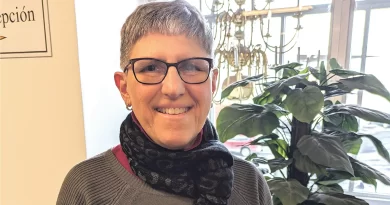Team Player – Joanne Marqusee Takes the Reins at Cooley Dickinson
When Boston’s Beth Israel Hospital merged with Deaconness Medical Center 18 years ago, Joanne Marqusee was there to witness the aftermath.
And it wasn’t pretty.
“I learned about what organizations should not do when they merge,” said Marqusee, the new president and CEO of Cooley Dickinson Hospital in Northampton, taking over for Craig Melin, who had steered the CDH ship for a quarter-century and through both quiet and turbulent seas.
With Cooley Dickinson having recently finalized a merger of its own, with Massachusetts General Hospital, she reflected on the smoothness of that transition compared to the tumult that followed the Beth Israel Deaconess deal in 1996.
“Being across the street from each other, in some ways it seemed like the perfect merger,” said Marqusee (pronounced ‘mark-a-see’), who joined the BI team in 1992. She noted that the two institutions had complimentary specialties; for example, Deaconess was known for surgery, while BI had a stronger medicine program. “On paper, it seemed like a match made in heaven. But in some ways, there really wasn’t enough attention paid to how to bring two cultures together, how to manage people through that situation. And it really matters.”
Staff from the two Boston institutions became notoriously suspicious of each other. “People didn’t want to work in teams. Fortunately, I had been there only three years, so I didn’t define myself as a ‘BI person.’ I didn’t have this bias based on what side of the street I worked on. That didn’t define my contribution to the corporation.”
On the bright side, however, “when the organization was in such flux, with people coming and going, there were a lot of opportunities,” she said. “So I was given more and broader responsibilities — often in areas I didn’t necessarily have any background in.
“I kind of learned over time that management is management,” she continued. “Particularly as a non-clinical person moving up in healthcare, I applied the same approach to problems involving people, whether in a clinical or non-clinical area.”
Having most recently served as executive vice president and chief operating officer at Hallmark Health System, located just north of Boston, a job she accepted in 2009, Marqusee is embracing her first stint in the CEO’s chair, and has been pleased with the way Cooley Dickinson and Mass General are coexisting.
“The distance makes it almost easier; people don’t feel threatened,” she told HCN. “And they have been terrific. We can call there for help; they have such intellectual capital. I spend at least one day a month at MGH and feel like a part of their team, which is nice.”
Matthew Pitoniak, who chairs the CDH board and led the search committee tasked with replacing Melin, is impressed with Marqusee’s acumen for bringing different teams together within an expansive health system, one that includes the hospital, the Cooley Dickinson VNA, and a number of other practices.
“We set out to identify a person capable of leading our care system into the future,” he said. “We also wanted a strong collaborator who can bring together the components of our care system for optimal patient care, and a leader who could build upon our affiliation with Massachusetts General Hospital while strengthening our local system.”
On a Mission
Marqusee was raised outside New York City in a family that was politically involved and socially conscious. “All my siblings and I ended up doing mission-based work in one way or another.”
Attending Cornell University, she didn’t know what career path she wanted to take, but she had a love for international affairs and languages, so she majored in linguistics. But she eventually felt a call to nonprofit management.
“I thought, ‘should I be a social worker?’” she said. “But I had a sense that a better fit would be to look at how whole organizations work and to make an impact there.”
While earning a master’s in public policy from Harvard University’s Kennedy School of Government, she decided she was more analytic than she’d suspected, and wound up working in New York Mayor Ed Koch’s first administration. There, in 1984, she was exposed to the Health and Hospitals Corp., which ran 11 public hospitals, five nursing homes, and dozens of ambulatory-care sites. It was a $2 billion corporation with 50,000 employees.
“After about a month, I realized I wanted to be in the healthcare world,” she said. “It was so complicated; I had the sense I could spend decades in healthcare and have different roles and always be learning.”
From there, Marqusee joined Beth Israel in 1992 and eventually ascended to senior vice president of operations for the merged system. She eventually ran most support and ancillary areas of BI Deaconess, including the Laboratory, Pharmacy, Radiology, and other clinical areas, as well as non-clinical areas such as housekeeping and patient transport.
“I got an appreciation for the fact that hospitals aren’t just doctors and nurses, even though TV and movies tell us they are,” she said. “I really got to see how, if you could tap the creativity of what’s considered support staff, it can make a great deal of difference.”
Take transport personnel, for example. “Follow one of them around for a day and see what a difference they make in healthcare,” she said, noting that patients are often already anxious and confused as they’re being moved from a room they know to somewhere unfamiliar, and a transporter who engages that patient with information and compassion makes a huge difference. “If nobody talks to them, it can be quite frightening.”
Eventually, though, Marqusee sought a new challenge. “I loved BI Deaconess; I loved the fact that it was an academic center. But personally, my interest and skill set is on the clinical side of medicine, and while teaching and research are good — we want to find a cure for cancer and teach the physicians of the future — my skills at managing people, bringing people together, can make more of a difference on the clinical side. I wanted to work in a community hospital.”
So, in 2009, she took over operations of the community-based Hallmark Health System, which is comprised of acute-care hospitals Lawrence Memorial of Medford and Melrose-Wakefield of Melrose, with more than 300 beds, as well as several ambulatory-care centers, a home-health agency, and a school of nursing. There, Pitoniak said, she spearheaded improvements in clinical quality and safety, financial stability, service excellence, and employee, physician, and patient satisfaction.
“Hospitals are complicated cities with 24/7 operations, involving doctors, nurses, phlebotomists, transporters, people who make sure supplies get where they need to go — it’s this complicated dance to make sure everything gets done right,” she said.
“There are a lot of policy issues, but also the question of, how do you make such a complex organization work better? How do you make teams work better?,” she went on. “The emergency room, for instance, is an amazing thing — think of all the different parts that have to come together to move everyone from A to B.”
In her five years at Hallmark, she said, she helped standardize practices and managed to improve both patient and employee satisfaction, while better engaging physicians — even while battling the onset of a recession that made life difficult for all community hospitals.
“In 2009, it was awful. People were losing their jobs, and if not them, their spouse was losing their job. It had a huge effect in all hospitals,” she said. “We were able to get through that and find ways to reduce costs while improving care. As a non-healthcare person, I like to apply the quality-improvement approaches of other industries, like the LEAN approach that Toyota uses. That’s very helpful in bringing frontline staff together, standardizing workflow, and finding ways to keep the patient at the center.”
Marqusee added that she wants employees at all levels to enjoy their jobs. “That’s important. People like it when they have fun and work as a team. For staff, it’s important to balance the seriousness of what they do with enjoying the community they work in. People come to healthcare, usually, because they care about what they’re doing.”
Western Swing
While Marqusee loved being in a community hospital, she occasionally missed the learning experiences of an academic medical center, and the opportunity to lead a Mass General-affiliated CDH appealed to her. “I wasn’t sure what I wanted to do, but when this came up, I was really excited; it seemed like the perfect job for me. It’s a community hospital that’s very well-regarded with high quality scores — very, very impressive.
“I hadn’t thought I would leave the Boston area, but my twins grew up and were in college, and my husband recently retired,” she went on. “Northampton seems like such an ideal area, really, with the culture and level of activity here. We can be connected with Boston, and not far from New York.”
She cited the hospital’s well-known infection-control efforts as one example of how CDH has been a leader.
“The focus on quality is clearly embraced here; physicians and staff are proud of being innovators,” she said. “Some people think hospitals and healthcare systems are solely based upon healing people, but harm can happen in hospitals. We want to make sure people don’t leave with an infection, and we make a priority of that. The housekeepers are passionate about this issue. They think, ‘what I do makes a difference in whether patients get sick here or not.’”
At the same time, Marqusee takes the reins amid controversy over a state investigation into several serious incidents in the Childbirth Center, including two infant deaths and a failure to properly treat high blood pressure in a mother, leading to a stroke that caused her death. The hospital has since reorganized the center and its affiliated nurse-midwife practices and launched a corrective action plan.
“We’re trying to be out there and communicating,” she said, noting that the recent tragedy comes on top of stress that already existed related to the Mass General merger and Melin’s announced retirement. “It’s been a year and a half of people not knowing what’s going to happen. So we communicate with them the good and the bad, the issues we need to work on, trying to be honest so we can get better. We’ve been as open as we can about the Childbirth Center to staff and the community.”
She credited Melin with steering the hospital with a steady hand amid an ongoing shift in the healthcare industry toward accountable care, which emphasizes efficiencies of treatment. “In America, we use more healthcare, but we don’t necessarily have better health outcomes.”
She said Northampton is a progressive community when it comes to understanding, for example, that more MRIs are not necessarily better, but added that the industry has a long way to go toward a less-wasteful system of care.
“Physicians get paid to see patients; they don’t get paid to talk on the phone,” she noted as another example. “But even five minutes on the phone can be more valuable than having them come into the hospital, be exposed to more germs, and maybe be encouraged to take an unnecessary test.”
What Cooley Dickinson can do, Marqusee said, is improve its own processes, and that begins with better communication between departments.
“We’re trying to understand where our systems do not work as well as they could, to connect the departments with one another, communicate better between the day shift and evening shift,” she said.
“The departments themselves run quite well; this place is strong operationally. They don’t need a leader to come in and tell food services or the ICU how to run their department, but they could use help linking to one another in interdisciplinary teams,” she continued. “Most errors in healthcare tend to be around communication or handoffs, radiology to ICU, day shift to evening shift, communication between nurses and physicians, nurses and technicians. I’ve been interested in finding where the gaps are and setting priorities for improvement projects.”
Take the Emergency Department, for example. “That’s such a complicated place — the doorway to the organization in many ways; a hospital’s reputation in the community tends to rise and fall with the Emergency Department,” she told HCN. “But the ED staff themselves say we could do much better with the way we communicate with people upstairs, so in the fall, we’re launching a major project to reorganize how we work in the ED, make it even better.
“Right now, patients are happy with it,” she stressed, “but if they spend less time here, it would make them even happier.”
Talk It Out
In her first two months on the job, Marqusee has been busy spending time in many different areas of the hospital and, in fact, the entire CDH network. “I’m trying to make people understand that it’s not just a hospital; Cooley Dickinson is also the VNA, off-site physician practices, radiology, and rehab,” just to name a few, she said.
“I’m also trying to meet people from different shifts — nights, weekends, evenings. It’s a whole new world at night, so I’m trying to understand their challenges, too. I’m just trying to create some visibility; I don’t want anyone to think the CEO is a suit in the corner office they can’t talk to. I want to have a culture that’s not hierarchical, where the frontline staff understand that I care about them, and they can talk to me.”
The bottom line, Marqusee said, is that, despite recent challenges, a well-regarded hospital system has the ability to improve, and that’s not a task she takes lightly.
“I feel like this community values Cooley Dickinson, and that doesn’t just happen,” she said. “It’s years of reaching out and providing valuable services.”





Comments are closed.